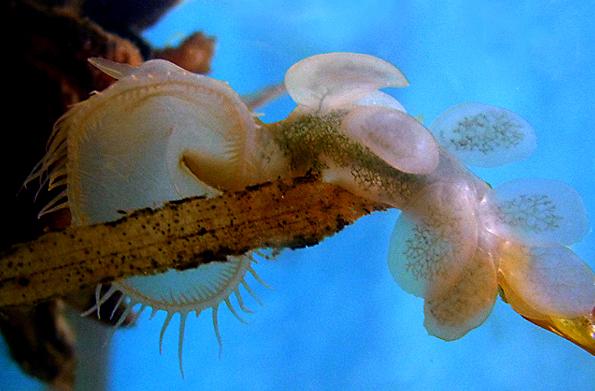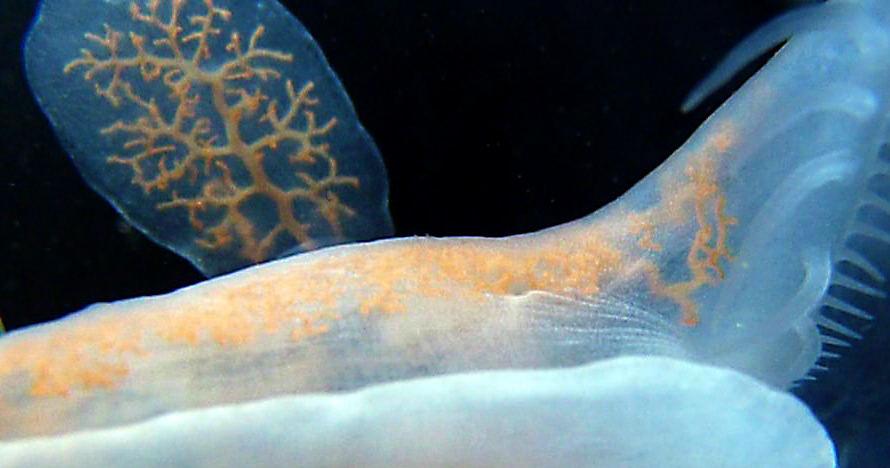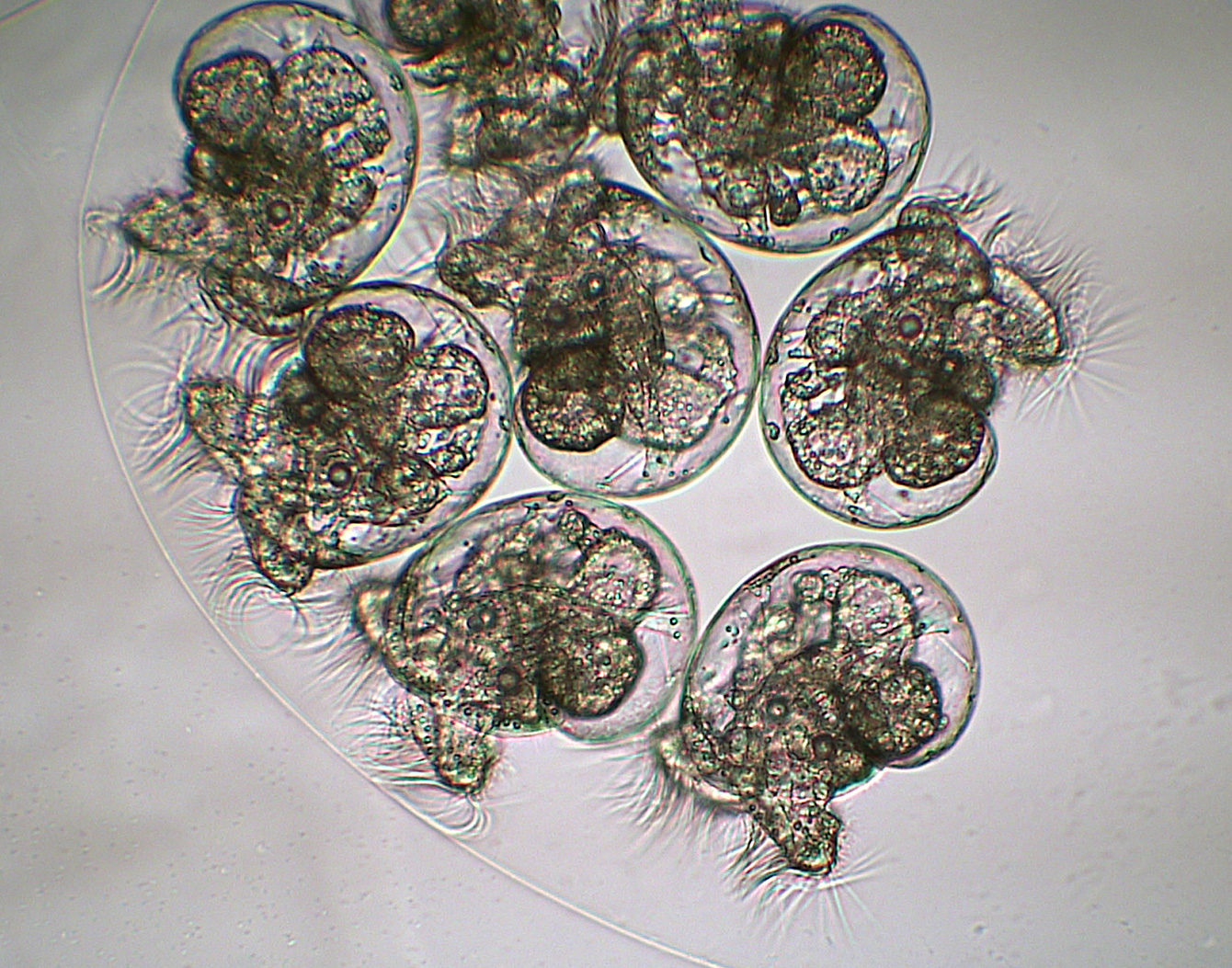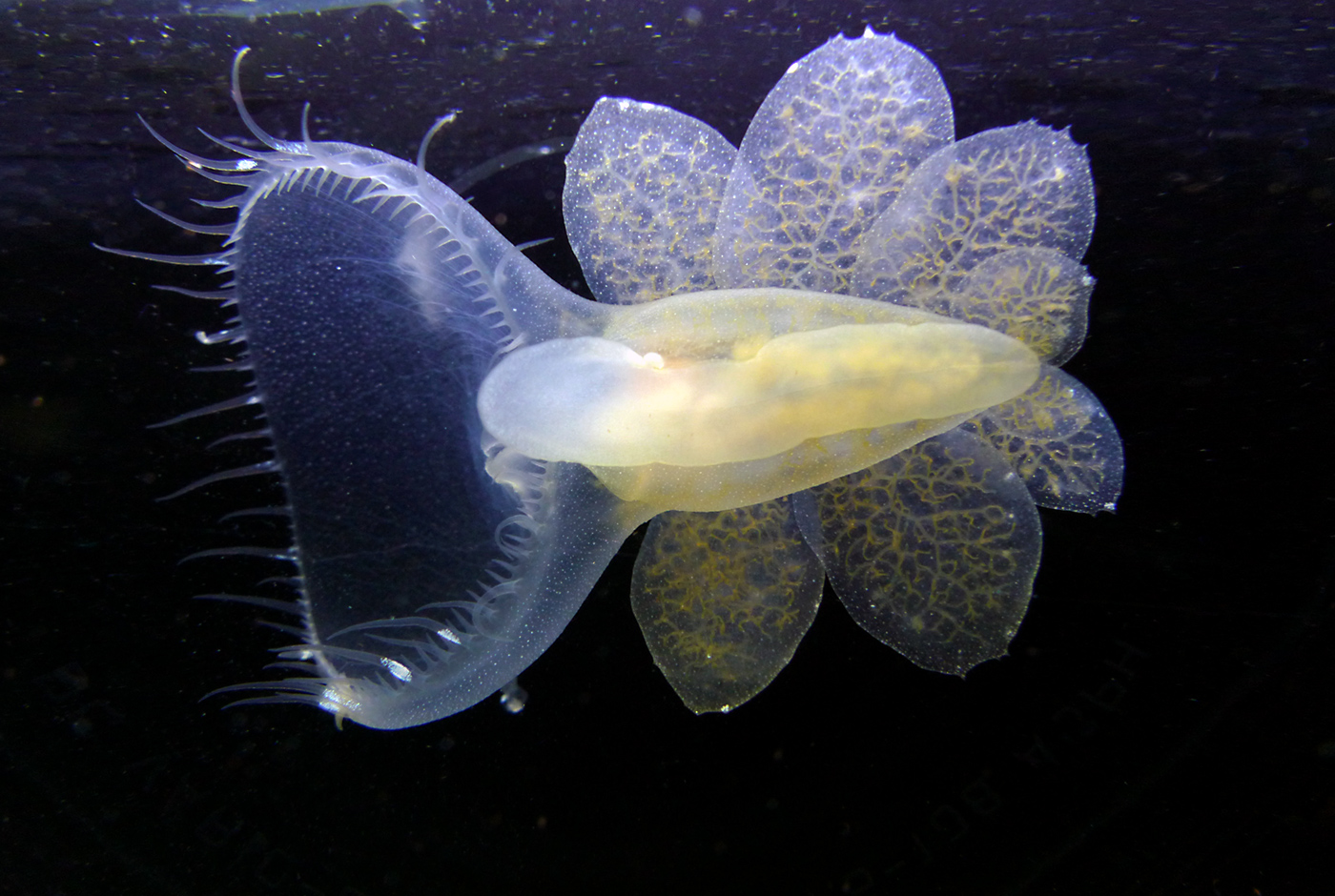Author: Maggie Ikeyima
Common names: Hooded Nudibranch, Lion Nudibranch
Scientific name: Melibe leonine
Size range: Up to 10cm long, 2.5cm wide and 5cm across oral hood.
Identifying Features: The Hooded Nudibranch is a translucent white, yellow, orange, or greenish organism – it often depends upon what it has been feeding upon. It has a distinct round oral hood for what could be seen as a “head”. Another feature to note, is that they are more gelatinous than a typical sea slug. When the hooded Nudibranch is taken out of water it gives off a sweet fruity aroma. It smells like watermelon and is produced in glands to act as a deterrent to predators. They have two rows of paddle-like cerata along their backs and the extensions of the gut – the digestive diverticuli – can be seen within.

Habitat: Hooded Nudibranchs have been seen to live near low tide waters and in kelp forests in deep waters. They are commonly found clinging to eelgrass (Zostera marina) with their large foot, but they are also found on different seaweeds such as the blades of the Giant Bull Kelp (Nereocystis luetkeana). It is typical to find them from 0 – 328m in depth. From what I have seen in the aquarium, the Hooded Nudibranch does not seem to be bothered by sharing its habitat with the many other marine organisms.
Prey: The Hooded Nudibranch is a carnivore. They attach themselves to the under-water grasses, for example, and once the they feel their prey the fringes of the tentacles overlap, which then holds the prey and forces it into the mouth. The food then moves through the esophagus to the stomach. They feed as long as food is present but will eventually stop once they are satiated. They eat planktonic fish, small molluscs, and other invertebrates such as copepods, and zooplankton. In captivity they feed on newly hatched brine shrimp (Artemia spp.).
Predators: Predators of the Hooded Nudibranch would include fish, kelp dwelling crabs and sea stars. A quite unique defence for the Hooded Nudibranch is how they are to drop one of their cerata to distract the predator for just enough time to get away. Hooded Nudibranchs are quite entertaining swimmers as they flex their body in a side to side rhythm upside down to escape.
Life Cycle: Hooded Nudibranchs are hermaphrodites. This means that each one has both male and female reproductive organs. When reproducing, two would fertilize each other and then lay their eggs on, most commonly, kelps. Hooded Nudibranchs internally fertilize which is quite rare. Their eggs are tightly coiled in cream or yellow-coloured coils or wave-like folds. After fertilization the eggs develop into veliger larvae that initially have shells but these shells are eventually lost. Hooded Nudibranchs live for approximately a year and die once they lay their eggs.

A close-up of the cerata of the Hooded Nudibranch (Melibe leonina). This one has been feeding on orange brine shrimp and their remains can be seen in the digestive diverticula in the cerata. When threatened the cerata are cast off (autotomy) so the Hooded Nudibranch can attempt to escape.

The veliger larvae of the Hooded Nudibranch (Melibe leonina) are shown to the left. You can see their shells, they will eventually lose, as well as the two large cilated velar lobes. Watch the video above to see these larvae in action.
Our veliger video is featured in the True Facts episode “Freaky Nudibranchs” at 2:24.
Videos by Soledad Callo and David Young
Photos by David Young
Special thanks to Dr. Louis Page for her support and providing eggs of Pleurobranchaea californica for filming.
Illustration by Maggie Ikemiya
REFERENCES:
Kozloff,E.(1993). Seashore life of the northern Pacific coast: An illustrated guide to Northern California, Oregon, Washington, and British Columbia. Seattle, Washington: University of Washington Press.
Melibe. Monterey Bay Aquarium. http://www.montereybayaquarium.org/animals/AnimalDetails.aspx?enc=VsGX+Lst7QbpywJwSubJ7w==
Newcomb, J. (5 September 2008) Scholarpedia. Retrieved January 15th 2010 from http://www.scholarpedia.org/article/Melibe
(24 July 2009) Melibe leonine. Retrieved January 15th 2010 from http://en.wikipedia.org/wiki/Melibe_leonina#Life_cycle
(3 July 2009) The Bay Science Foundation, Inc. Zipcodezoo Retrieved January 15th 2010 from http://zipcodezoo.com/Animals/M/Melibe_leonina/
Bickell-Page, L. R (1989). “Autotomy of Cerata by the Nudibranch Melibe leonina (Mollusca): Ultrastructure of the Autotomy Plane and Neural Correlate of the Behaviour”. Philosophical Transactions of the Royal Society B: Biological Sciences. 324 (1222): 149–172.


